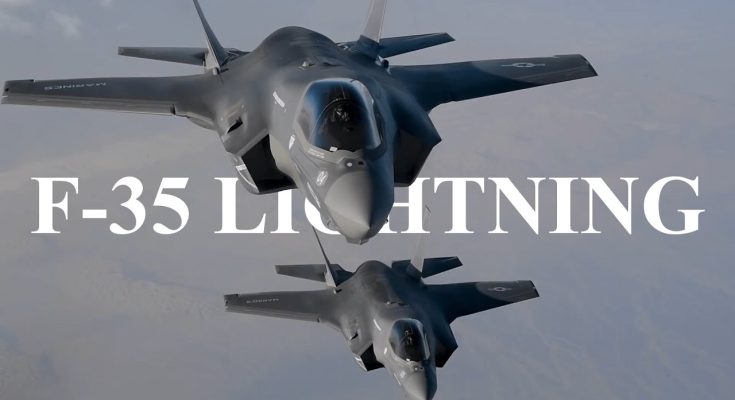The F-35 Lightning II is one of the most advanced and stealthy fighter jets ever built, representing the cutting edge of modern military aviation. When the words “Here comes the Lightning!” are spoken, they evoke the thrill and awe associated with one of the most powerful, versatile, and sophisticated aircraft in the sky. Developed by Lockheed Martin, the F-35 is designed to dominate in air combat, strike missions, intelligence gathering, and more, ensuring that it is a formidable force wherever it operates. The F-35 is more than just a fighter jet; it is a symbol of future warfare and the pinnacle of aerospace engineering.
The Birth of the Lightning
The F-35 program, initially known as the Joint Strike Fighter (JSF) program, was designed to create a family of stealth aircraft capable of fulfilling the needs of different military branches: the U.S. Air Force, Navy, and Marine Corps. The challenge was clear: develop a fighter that could be adapted for a variety of roles while maintaining stealth, maneuverability, and the latest in sensor technology. The F-35 was the result of this ambitious vision, a jet that would be adaptable enough to serve as an air superiority fighter, close air support, ground attack platform, and intelligence, surveillance, and reconnaissance (ISR) aircraft, all in one.
With its advanced stealth capabilities, superior avionics, and sensor fusion, the F-35 is designed to remain undetected by enemy radar systems while still delivering devastating firepower with incredible precision. These capabilities make the F-35 a true force multiplier, providing air superiority in some of the most contested and hostile environments.
Three Variants for Three Roles
The F-35 is available in three distinct variants, each optimized for different operational requirements:
- F-35A: The conventional takeoff and landing (CTOL) variant is designed for use by the U.S. Air Force and allied air forces. It is equipped with advanced avionics, a powerful radar system, and highly accurate weapons systems. The F-35A is an air-to-air and air-to-ground weapon platform that excels in a wide range of combat situations, including close air support, suppression of enemy air defenses (SEAD), and precision strikes.
- F-35B: This variant is capable of short takeoff and vertical landing (STOVL), making it perfect for Marine Corps operations. The F-35B can operate from smaller aircraft carriers, amphibious assault ships, and forward operating bases, providing maximum flexibility in a wide range of combat scenarios. Its ability to perform both conventional and vertical landings is a game-changer in modern military aviation, offering unparalleled operational versatility.
- F-35C: Designed for the U.S. Navy, the F-35C has larger wings and reinforced landing gear for carrier operations. This variant is specifically built to operate from aircraft carriers, offering advanced stealth and long-range strike capabilities to ensure naval dominance. Its ability to launch from and land on aircraft carriers makes it a crucial asset for projecting force and maintaining naval superiority in contested maritime environments.
Revolutionary Technology and Stealth
The F-35’s stealth technology is perhaps its most defining feature. Unlike previous generations of fighters, which could still be detected by advanced radar systems, the F-35 is designed with low observability in mind. Its sleek airframe, special coatings, and the careful integration of systems make it incredibly difficult to track by radar, giving pilots a significant edge in combat.
Moreover, the F-35 integrates an array of cutting-edge avionics that combine radar, sensors, and targeting systems to provide the pilot with an unmatched view of the battlefield. The Distributed Aperture System (DAS) and Active Electronically Scanned Array (AESA) radar allow the pilot to detect and engage targets at much longer ranges than ever before. Additionally, the sensor fusion in the F-35 integrates data from all onboard systems, presenting the pilot with a comprehensive picture of the operational environment in real-time, making the F-35 a true situational awareness powerhouse.
The “Lightning” in Action
When the F-35 roars into action, the “Lightning” moniker truly comes to life. The jet’s maneuverability, speed, and firepower allow it to adapt to a variety of roles quickly and decisively. In air-to-air combat, the F-35’s superior radar and stealth allow it to engage targets from long distances, often without the enemy even knowing it’s there. When it comes to precision strikes, the F-35 is capable of delivering smart bombs with incredible accuracy, neutralizing high-value targets with minimal collateral damage.
The F-35 is also equipped with the capability to carry out electronic warfare and intelligence gathering. This versatility makes it an essential tool for modern warfare, whether it’s flying alongside other fighter jets in a strike package or operating alone in contested airspace.
Global Impact and Future
The F-35 Lightning II has been adopted by multiple countries, with dozens of air forces, navies, and marine corps around the world now flying the jet. Its interoperability with NATO forces and partner nations ensures that the F-35 will continue to play a crucial role in global security for years to come.
As it enters full operational deployment, the F-35 is set to reshape air combat, offering capabilities that no other fighter can match. From its advanced stealth and radar systems to its ability to operate in diverse environments, the F-35 is a true game-changer in the world of military aviation.
The F-35 Lightning II is not just a fighter jet; it’s the embodiment of modern warfare, bringing unmatched power, precision, and flexibility to the skies. When it takes off, it’s more than just an aircraft—it’s a symbol of the future of aviation. “Here comes the Lightning!” and with it, a new era of air dominance.



